SONY
CDP-227ESD
modified in August 2007
Also See the comments 16 months later when I managed to do the ultimate
mod of this player - Non oversampling conversion
WHAT ? Sony with TDA? Crazy or what? Two TDA's ?
I had to buy this one just to see it.
(they sell below 100 Euros, mine was 130)
It is identical with the UK variant CDP-507ESD and the Japanese CDP227
(in
Europe called CDP-950) has single TDA1541A but the 337ESD beats them
all,
having two TDA's and the fabulous KSS190 mechanism. I also owned the
CDP-555 ESD and the CDP-333ESD
This is one wonderful player. Made in 1989. It was a part of
co-operation between Sony and Philips/Marantz.
They used one of their best transport with Haal motor magnetic
"sledges", KSS151A laser, etc.
The famous green PCB is fantastic, much better than Philips PCB's.
No SMD caps, no cheap parts. All super duper audiophile approved stuff.
Elna Audio caps everywhere. Only one good OP-AMP per channel. So far so
good.
Funny, SONY positioned this model low, despite it being one of the best
CD players in the World ever made.
Their own series of ESD has two more models - better than this one
because of better transport: CDP-337 ESD and CDP557 ESD. In Japan this
model
227
was called 508ESD and 509 for the 337 respectively. I think 337 is
optimal choice, loosing to 557 only by the fake wooden cheeks on the
side. It has substantially better transport (KSS190) and 2 x the weight
due to much stronger metal chassis and beefier transformer. the 337 is
damn close to Grundig Fine Arts CD-9009 player.

Immediate track access, remote controlled motorized variable output
with ALPS, very legible display - nice features.

Why 4? There are 2 DACs in parallel, but as all companies they put a
lot of bullshit on the front of their product.

You can see this picture in high resolution if you right click on it.
I removed disc clamp to show the laser.

Every capacitor in this player is a premium grade ELNA !!! All is nice
and Gucci here.
Look at these copper radiators on voltage regulators. So cool.

I see - they wrote "18 bit filter" to pretend the CD is "18 bit"
whatever that means, but the dac is 16 bit anyway,
as well as the whole format.
Inside the SONY CDP227ESD

Two TDA dac chips are simply paralleled. But no S selection. So better
than single chip, still not as good as Grundig 9009 (two S selected
chips)
Is this a material for the best overall lampization CD?
The TDA1541A DAC

Close up TDA1541A
14 premium MKP decoupling caps.
Bravo Sony. Ferrite rings on digital power supplies. 7805 regulator
super close to the DAC.
Everything you can dream about in the player.
Laser of Sony KSS151A

Magnetic suspended rails that hold the super cool SONY laser system.
KSS151A.
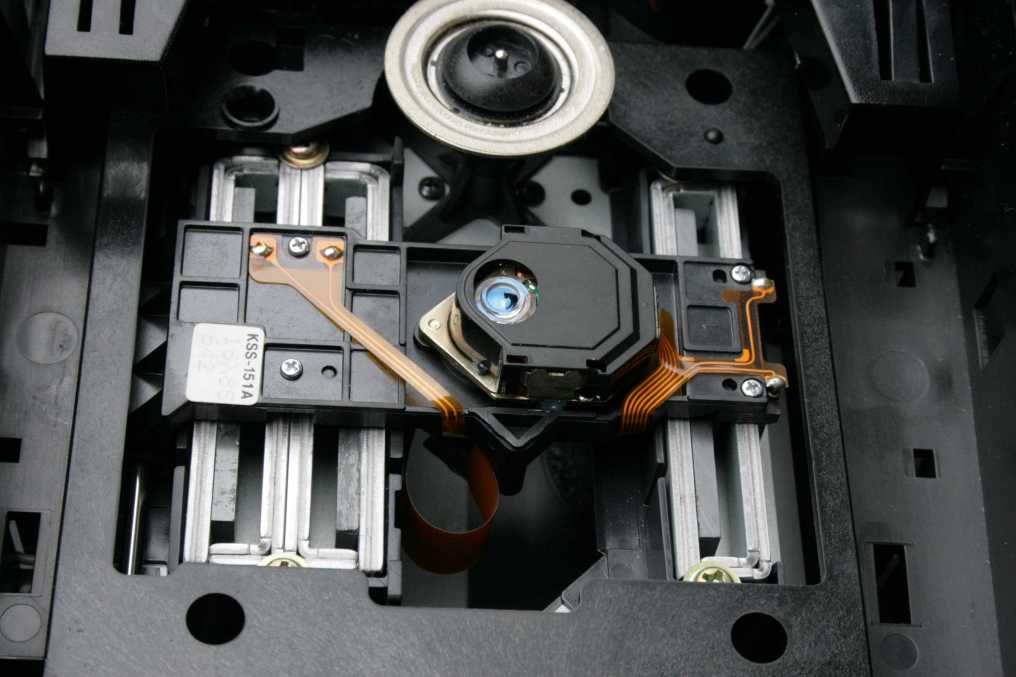
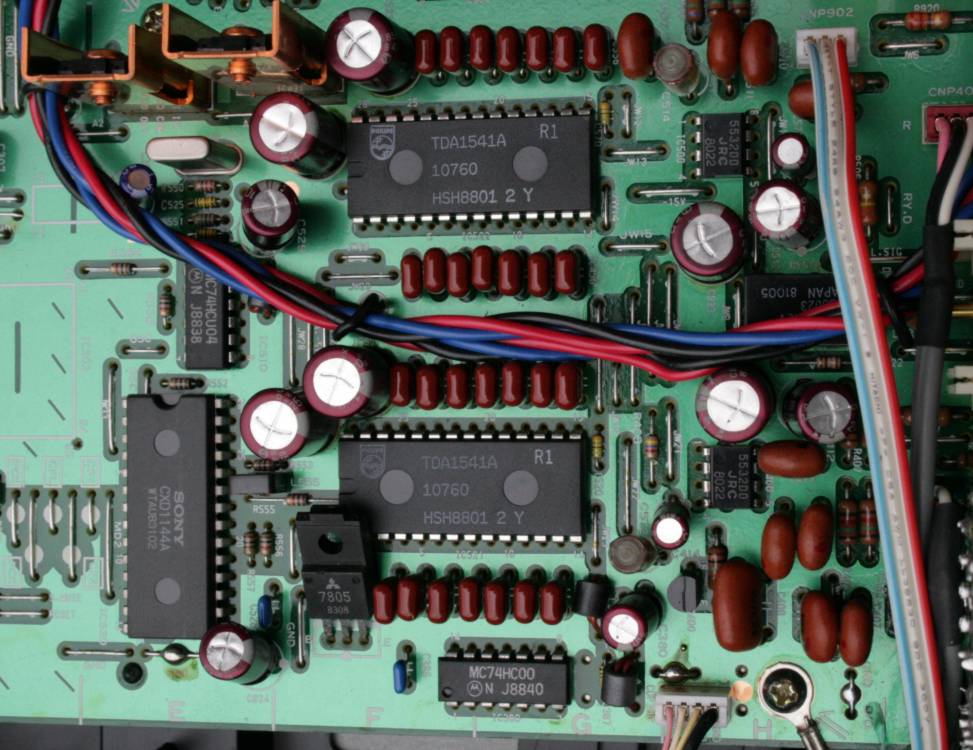
The TDA1541A again - top view.


Underside of PCB. Note nice silk-screen "help" tips - for example which
leg is which in a chip.

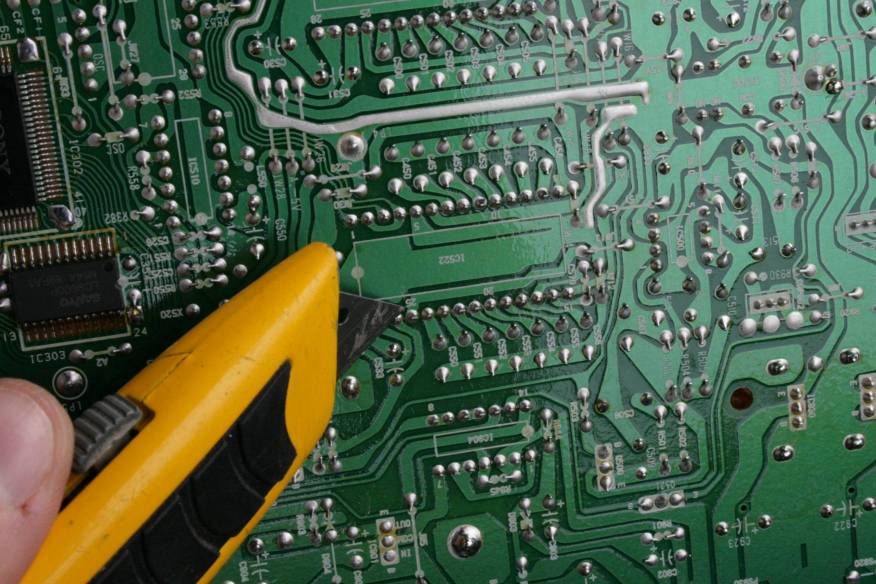
For resistive I/U conversion I cut 25th and 6th tracks in BOTH chips
and paralleled them by wire and connected the summed signals to tube
lampizator pin 7, where by 60 Ohm to nearest ground on pin 9.
The top of this resistor forms the VOLTAGE signal source connected
directly to the grids of tube.
If you have transistor amp or preamp - use 20 Ohm converters to lower
the signal level.

SUMMARY: This is one hell of a CD player. It is just a touch below
quality of the champions of TDA1541A league - Grundig Fine Arts
CD-9009, and Cambridge
CD3. It's mechanism and DAC are both first class, but I very slightly
subjectively prefer the sound of Philips swing-arm transports like CDM
0, 1, 2 and 4.
The PCB is one of the best I ever saw, and I saw a lot.
Pro lampization: low price, no nonsense look and engineering,
relatively easy to
find laser, unique double DAC arrangement, no need to tweak or tuning
of the capacitors and power supplies. Capability to impress people who
know no better than High End megabuck machines.
AGAINST: very tight space, no place for transformer, nothing more.

Summer afternoon lampization of
sony CDP-227ESD.
Transformer had to go to the
front panel - no other space.
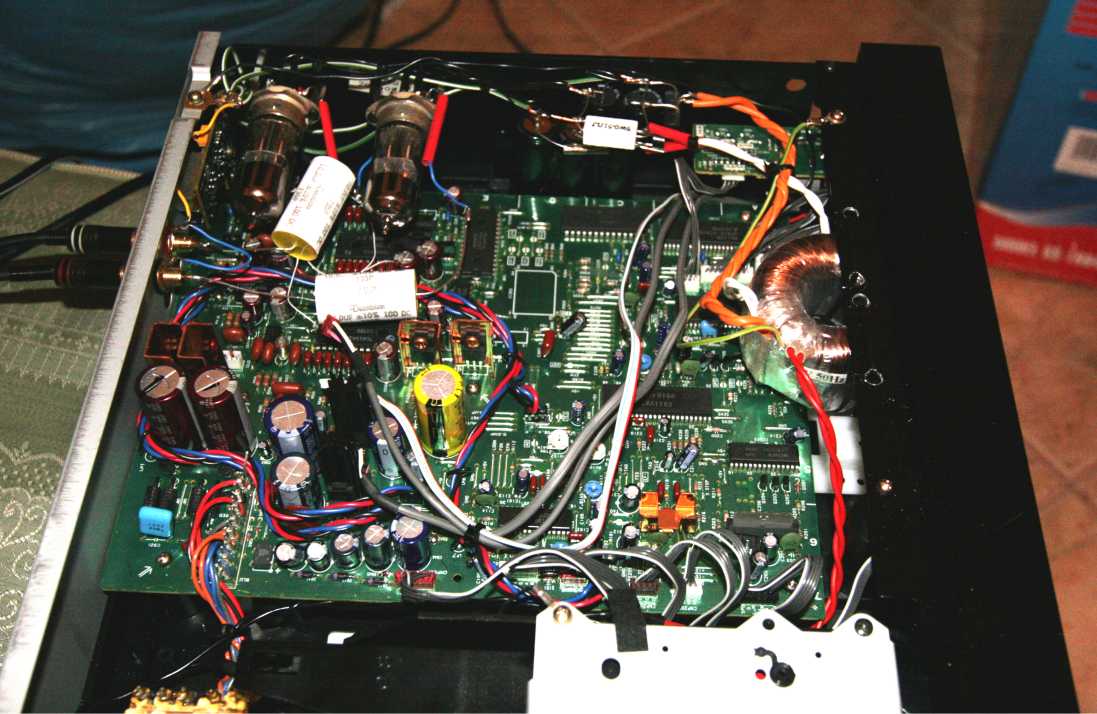



Oooops the wino is here by mistake. Someone left it on the table ???


Transformer is in the front panel space, power supplies - on the right
side from PCB, hot melt glued to the plastic chassis.
RCA outlets are fitted in the regular place on the back, tube sockets
are mounted to the plastic sides. Later on I replaced the MKP coupling
caps to the output RCA's with 2uF paper in oils. Sound much better.
Tubes: 6H1P (6N1P) - not 6H6P because they sound better in this
particular context.
After doing the messy and quick version (above) i re-installed the
tubes on the outside, while killing the digital output. Who needs it
anyway?

Sound of lampized Sony CDP-227ESD
I can no more describe my own
players. This one is very good, it
achieves 95% of the reference Grundig. That means it is DAMN GOOD.
This player gets my high
recommendation.
I made four of them already and all are loved by their owners. I am
seriously thinking of buying two more for myself just to have one for
listening and one as part donor in case something fails.
I Installed the masterclock in one player and A-B'd them side by side
on same CD material.
The difference was so subtle, it was overshadowed by the IC cable
difference. I don't have two sets of IC. The clock - in my private
subjective experience - does not make audibly superior sound. But
I believe it is system dependent, clock dependent, and power supply
dependent. Don't take my word for it.
2 YEARS LATER: THE NEW TUBE 6N2P arrived
Direct plug-in of 6N2P will blow you away if you already liked
the 6N1P
!!! Highly recommended , please upgrade immediately !
Just please read the SATCH story
I am not yet sure how to make NOS in this player, but I must try it
some day. I think NOS is a must.
NOS for the
SONY CDX1088 digital filter
The Sony players like CDP-555ESD , and some others like Nakamichi
CDP2-e do not use the SAA7220p/B but instead they use Sony CDX1088
chip. Some later modells use CXD1144P
It basically works the same as the Philips, but it is SMD hence it is
hard to solder to its legs.
The CDP-555ESD
has 4
times oversampling applied inside the chip that precedes the Philips
DAC
TDA1541, which is SONY CXD1088. We can identify the pins which carry
I2S signals and bypass the chip by means of a bridge of 3 wires a'la
Philips
7220p/B. BUT..... the sony chip is so small and it is SMD that the
soldering is too difficult for me. Even with 10 x magnifying glass and
a sharp soldering tip I am unable to do it properly.
The tracks leading to and fro this SONY 1088 or CXD1144P chip have no other
points
where I could tap to them. The only possible scenario is to solder to
chip legs.
I thew the towel. Sorry. Maybe I will try one day again.
A month later I decided to try
it. I chose Sony CDP333ESD and I bridged the I2S signal over the
CXD1088 . The rersult was a mixed bag - there was sound audible only at
MAX amplifier volume. So the player played OK, but it was somehow
muted. I found 3 different MUTE pins on three chips around. I
experimented with isolating, floating, grounding of these pins - and no
success. The music was audible but probably -60dB. I gave up untill
someone tells me where I went wrong.
BINGO !!!
November 2008
Thanks to the power of internet, I got some help from very kind pen-pal
Mr. Avinash. He suggested a digital trick which basically changes the
internal data protocol betweek SONY chips wihich preceed the TDA1541
DAC.
Here is what he says:
I thought I would let you know that I
have now successfully made the NOS mod to the Sony CPD 227ESD. (L.F.
> It is also directly applicable tyo Sony 950, 710, 337ESD, 333ESD
ESD, 555 ESD, and probably also to the Nakamichi CDP-2e)
The
main issue to solve is that the output of the Sony DSP chip CXD1125 is
in the Sony/EIAJ format and not the Philips I2S format. The easiest way
to convert the Sony format to the I2S format is to delay the LRCLK
signal by 7 bit clock pulses and swap the analogue outputs of the
TDA1541A so that what was previously the Left channel ouput becomes the
Right channel and vice versa. BCK and DATA can simply bypass the
CXD1144P filter chip.
I used a 8 bit serial in, parallel
out (SIPO)
shift register (74HC164A) chip which costs about 20p in the UK. The
input to the chip is the LRCLK signal from the CXD1125 chip and I used
the 7th bit as output to the two TDA1541A's. You also have to take a
parallel BCK signal to this chip as well as +5V (taken from the
CXD1125) and ground. If you take a look at the datasheet, copy
attached, you will be able to see how it works.
This gives full volume (and full
resolution) on the analogue outputs of the TDA1541A.
I
was getting some noise when the CD player was not playing any CD's but
this goes away if you switch the Digital Out at the back of the CD
player off.
The sound out is analogue like and
flowing very much
like other NOSed TDA1541A CD players but the 227ESD also appears to
have better resolution and clarity. It is a little bit better then my
NOSed Marantz CD40 to my ears.
I am listening to it right now and it
is sounding very good!!!
The pin connections I used on the
74HC164A are:
Pin 1 - LRCLK from CXD1125 taken from
before R540 connection with R540 leg lifted - input clock
Pins 2,9,14 - +5V from Pin 8 of
CXD1144P supply line
Pin 7 - Ground
Pin 8 - BCLK from before R542 with
R542 leg lifted.. Same signal goes to both TDA chips leg 2 and 2.
Pin 12 - Output LRCLK to the
TDA1541A's legs 1 and 1 parallel. - left-right switch clock
The remaining DATA signal goes from any of the R541 sides of
resistor to both legs 3 of TDA1541 paralleled,
All other pins of the 74HC164A are unused.
This already plays FANTASTIC music but makes some noises on pause.
From Lukasz:
CDP227ESD has all points of interes exposed on upper side of PCB.
We have the BEFORE CXD1144P
FILTER points where the digital signal must be
captured: Resistors R540, R541, R542 carry data, BCLK and LRCLK
signals.
AFTER CXD1144P FILTER there
are elements that must be lifted: R553, 555, 556 and
557. L555 (coil in a black box)). I broke them irreversibly by pliers.
DATA goes directly across the FILTER chip. LRCLK goes by means of the
new chip 74HC164A which shifts it. BCLK goes across the filter to DAC
but on its way it touches 74HC chip pin 8. TDA as usuall is operated
with legs 1, 2 3 and 4 floated but 2 and 4 are connected. Both DACS are
parallel - all respective inputs shorted.
There will be garbage noise when CD is on pause or skipped to next
track.
The mute remedy is analog relay mute which used to mute the old signal.
We must find the output relay - the black box near old RCA ouitputs. We
connect the relay's legs marked NO to the RCA outputs.
Before that we must float these relay legs which used to go to old
outputs. During mute period the relays will ground the signal.
The mute works well for no play period, for play period, for fast
forwart and backward too. Only for the track skip there will be 1/10 th
of a second of unwanted signal. Small problem for a great improvement
overall.
The sound does improve a LOT. It jumps to the next upper class of
playback systems.
Strongly recommended.
In Sony CDP-333ESD with one TDA and CXD1125 demodulator and typical
digital filter CXD1088
we go like this: the whole job is done on the bottom of the PCB.
data goes straight from CCD1125 leg 78 (lift R311) to TDA pin 3
(floated)
BCLK goes from pin 76 of the 1125 (trace it to the first breaking point
- a jumper or resistor and then float it by lifting that part) to
the pin 8 of the 74HC and from there straight to TDA pin 2
(joined with 4 and together - floated)
LRCK goes from pin 80 of the
1125 (trace it to the first breaking point - a jumper or resistor and
then float it by lifting that part) to the pin 1 of the 74HC and
from pin 12 (output of 74HC) to TDA pin 1 floated.
FROM THE DATASHEET:
MC74HC164AD - 8-Bit Serial-Input/Parallel-Output Shift Register
High–Performance
Silicon–Gate CMOS
The MC74HC164A is identical in pinout to the LS164. The device inputs
are compatible with standard CMOS outputs; with pullup
resistors, they are compatible with LSTTL outputs. The MC74HC164A is an
8–bit, serial–input to parallel–output shift
register. Two serial data inputs, A1 and A2, are provided so that one
input may be used as a data enable. Data is entered on each rising edge
of the clock. The active–low asynchronous Reset overrides the Clock and
Serial Data inputs.
• Output Drive Capability: 10 LSTTL Loads
• Outputs Directly Interface to CMOS, NMOS, and TTL
• Operating Voltage Range: 2 to 6 V
• Low Input Current: 1 mA
• High Noise Immunity Characteristic of CMOS Devices
• In Compliance with the Requirements Defined by JEDEC Standard
No. 7A
• Chip Complexity: 244 FETs or 61 Equivalent Gates

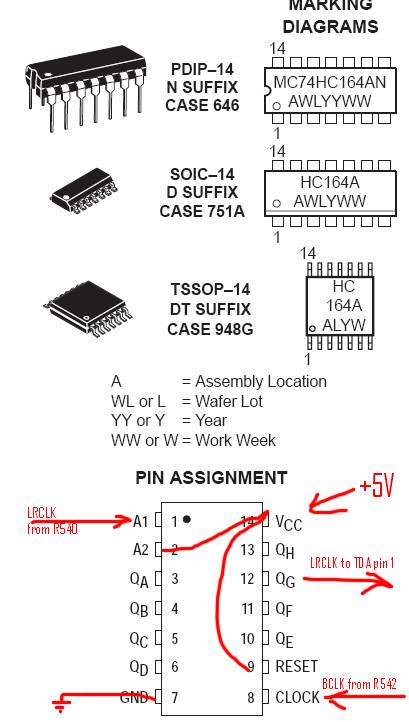
DATASHEET:
http://pdf1.alldatasheet.com/datasheet-pdf/view/12165/ONSEMI/MC74HC164AD.html

ABOVE: The hacker chip ready for implementation
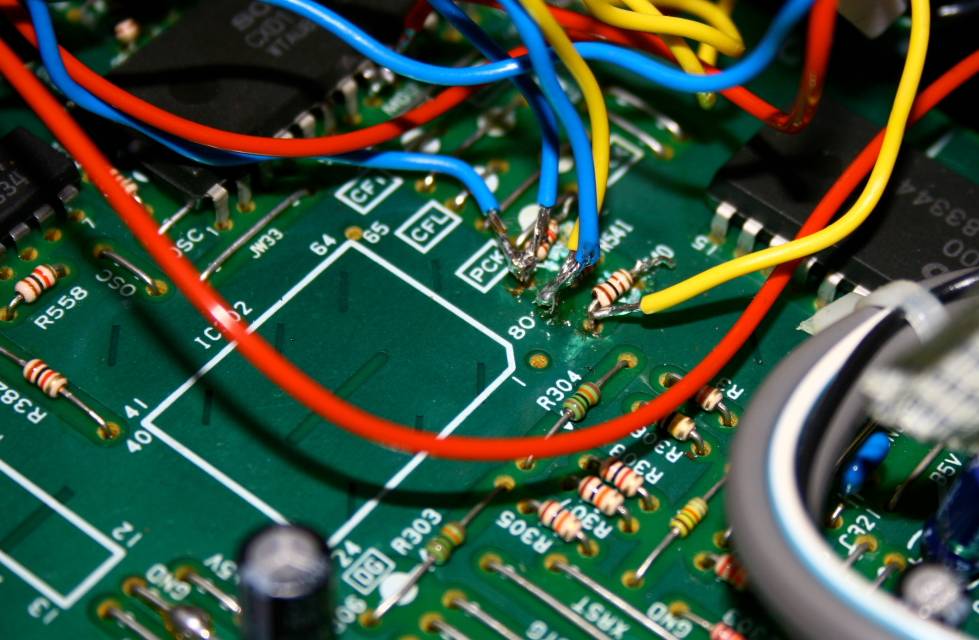
ABOVE: The signal stealing points from R540, 541 and R522.
The 540 and 542 are lifted on the side FAR from CD mechanism, 541
is not lifted at all, and all three are tapped from the resistor
end CLOSE to CD mechanism.
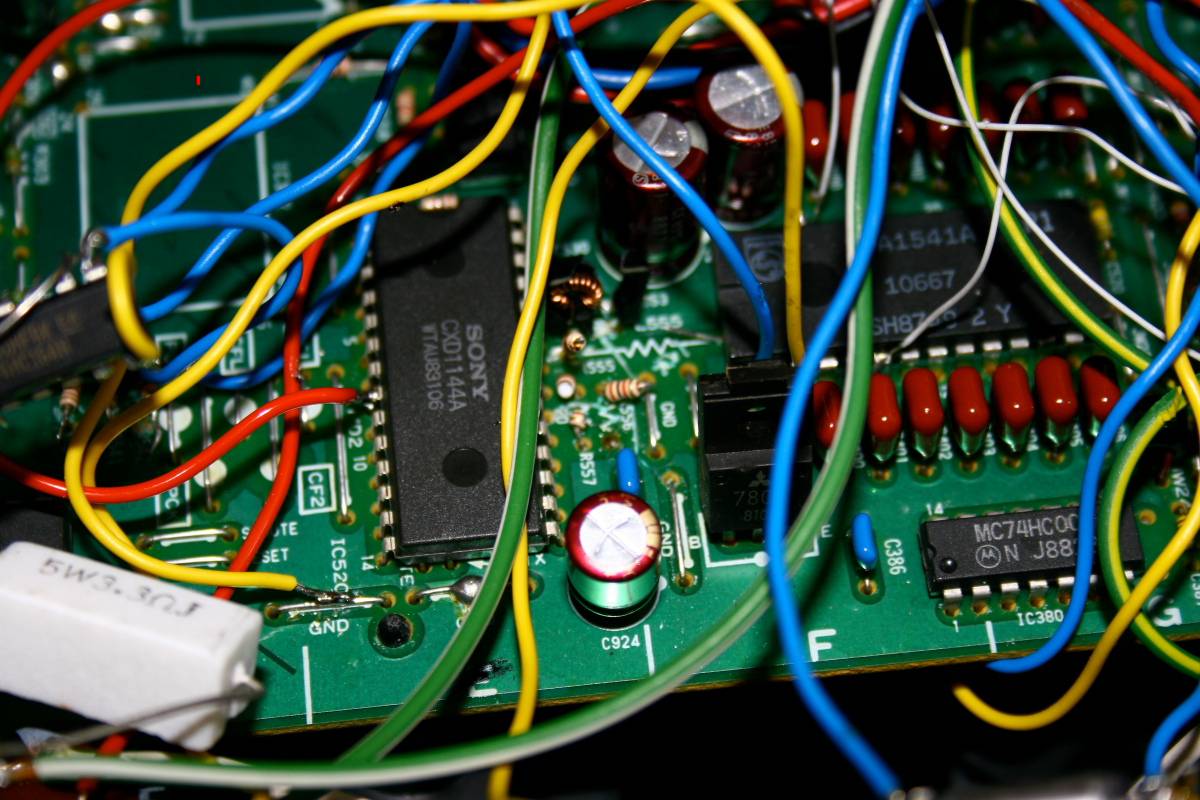
The armageddon of resistors AFTER the filter CXD1144 - R553, 555, 556 and
557. L555 all are lifted.

The black cube in centhe of photo is the Matsushita output relay. To be
used for grounding of RCA outputs to avoid nasty noises. In NOS mode
the filter no longer performs digital mute function and we must mute
the analog signal AFTER lampizator and AFTER output capacitors.
Just solder RCA's to the bottom of the relat to previously
floated pins marked NO. (normally Open Relay Dry Contect)
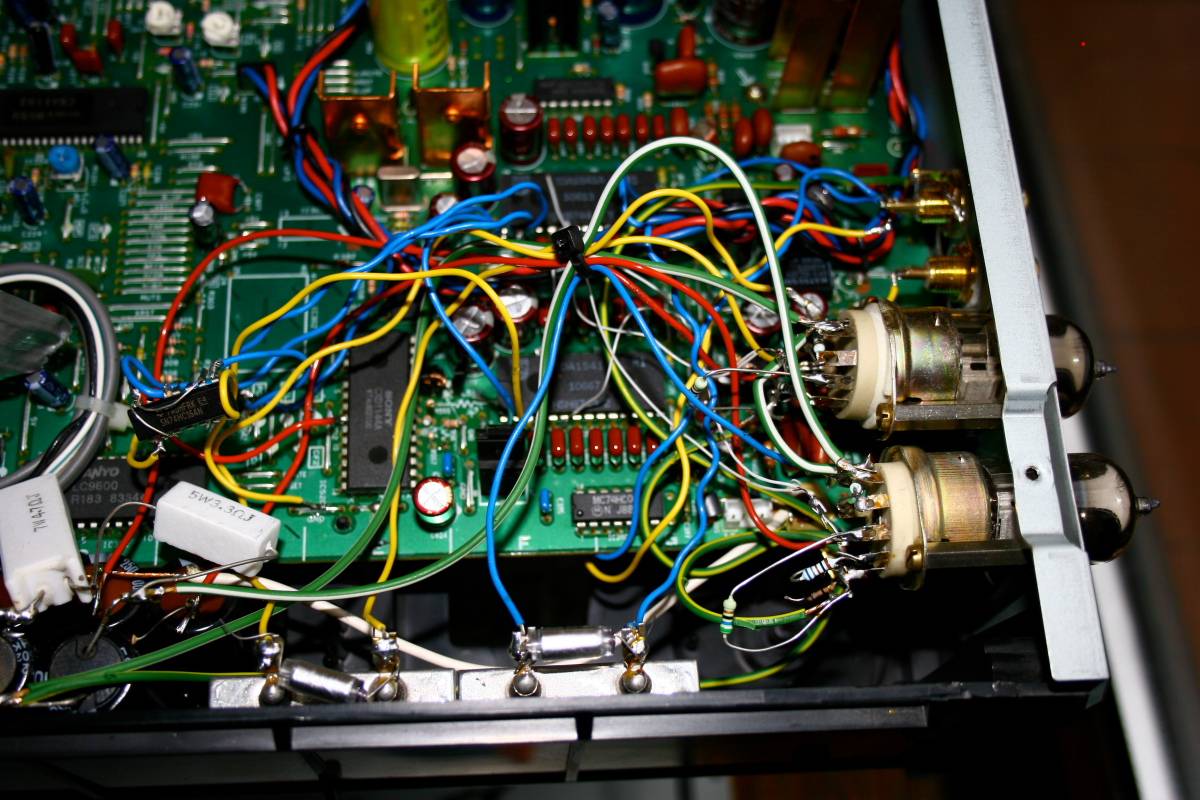
The full glory of the KING guts: Lampization, NOS and CLOCK. Like three
steps to Nirvana.
SONY family of ESD players in Non Oversampling mode (NOS)
after experimenting with my two players from that family - namely
CDP227ESD and CDP333ESD i draw a conclusion.
1. TDA1541A is a hell of a dac, its full potential is unlimited.
2. The Sony NOS implementation is better than Philips one, to be found
in Grundigs, Marantzes and Philipses. The difference must lie either in
the laser mechanisms (227 uses KSS151A and 333 uses a better (best)
KSS190A or BU1. Or it lies in the fantasttic sony demodulator chip -
the one which converts laser impulses into proper digital format
datastream. Or the difference is a sum of the two above. Anyhow - the
sound coming from NOSed and lampized ESD players is totally awesome.
3. Two DAc chips in 227 do sound better than one in 333.
4. 6N2P is best tube I know today for this particular application (in
SRPP mode)
5. if you love MUSIC not HiFi - you can not find anything better
without financial constraints. I guarantee it.
6. Oversampling in SONY family strongly degrades the sound in High End
terms.
It is very very hard to impress me
with all my experience and
knowledge, I was not prepared that there may be such a giant quality
leap waiting to be unleashed.
Even SATCH dac, which theoretically is
TDA at the limits - is inferior
to Sony CDP227ESD in NOS mode. That is understandable - SATCH must use
SP/DIF
process of transmission, and Sony is one box solution which does
without SP/DIF at all. All process is direct and very simplified.
As good as Sony 227ESD is on its own,
as great as it is with
lampizator, after NOS - the sound is drop dead gorgeous. It re-defines
my quality ladder, all classifications of sound quality must be
downgraded to make room for this new whole class of quality.
The pleasure of listening goes up
whole level, the amount of
information is beyond my wildest expectations. It is not about bass or
trebles, it is about the ease of understanding what is in the
recording. The details in background become so easily understandable,
the secondary instruments are miked anew. I hate to say the most
trivial sentence like "I heard things
I never heard before" or "I
listened all night as if I heard for the first time my favourite CD's "but
that is
just that - all intimately known recordings become totally new
experience. On general note, all aspects of reproduction become very
LOVABLE and "correct" - timbre, colour, space, timing, voices are
natural,
space is wiiiiidddeee, instruments clear, separated, audible. I cant
really describe it. It is far above my language skills to tell you how
good sound becomes.
From evetything I ever heard, the
CDP-227ESD "nosed" is by far the best
sound. This is so good that I would say it is the end of the road.
Absolute lack of desire to try improvements. It is what I dreamed about
all my life. I cant even write about it anymore - I rest my case.
Long live the new king on December 01 2008.s
BACK


























